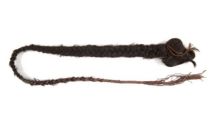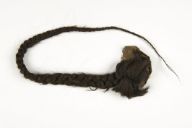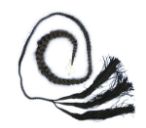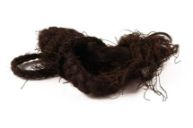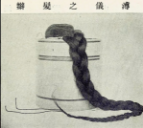Queue on the loose
After our queue was cut off from a man that had painstakingly taken care of it for so many years, it began a new life, with new owners, traveling to the other side of the world.
It was somewhere halfway into the 19th century that a European man happened upon this queue. He was a medical officer who, although born in a German state, had served the Dutch armies in Dutch East Indies from 1849 to 1873. As far as we can trace in the records, this man had never set foot in Qing China. Has our queue ever been in China? It must have been, right?
In 1899, following the death of this man, his wife sold the queue to the Volkenkunde branch of the Nationaal Museum Voor Wereldculturen, together with over 600 other items [RV-1239*]. In this lot, 125 objects are connected to China, including three queues. Our queue is the most colorful of the three. The second one is real human hair combined with a brown extension. Was the brown once white (the color of mourning)? The description of the third one is creepy: ‘Queue; skin’, it says. The hair and scalp is further said to ‘belong to an old man’. Why would this be real skin? Is this not a skullcap made of off-white canvas or leather to make it easier to carry when there is no hair, such as the specimen at MAAS?
The collection that is displayed in this marker constitutes all queues found in online collections. Of the 22, 15 are in the Netherlands. There are strong reasons to believe that eight of them, maybe even eleven, were brought back to the Netherlands from 19th century Dutch East Indies. Three to six of them went to the ethnological collection of Volkenkunde, including ours; another five went to Artis, a zoo in Amsterdam, before 1887. In 1921 Artis decided that the queues had no place in their collection, and donated them to the Tropenmuseum in Amsterdam. These are hints to narratives that are different from the voices of the elite students and the anti-Manchurian attitudes in the early 20th century that we have heard so far. Was our queue maybe attached to a fugitive of the 19th century anti-Manchu Taiping rebellion? Should we see them as the queues of those Qing subjects who reverted to Christianityin Dutch East Indies?
But we know more than when we started. The story of our queue makes a few things very clear: each and every queue has a unique story to tell about its bearer, its collector and the historical context in which it existed. It leaves us to wonder whether it consists of hair belonging to more than one human, or more than one species. The queue was listed as ‘Chinese’, but behind this simple predicate lies a story of Manchus and migration, of fashion and intertwining human hair, horse hair, silks and other fabrics. Our thing is partly human - or did that stop when the queue was cut?
